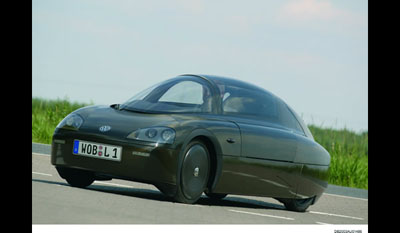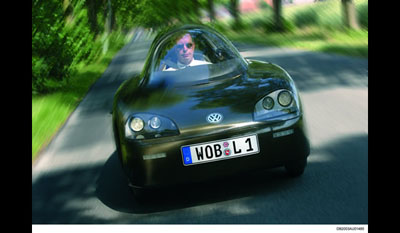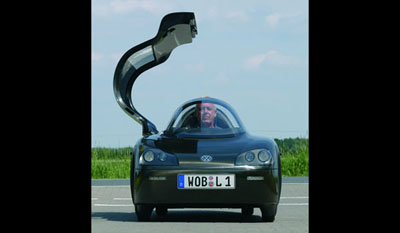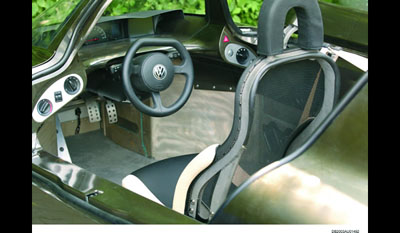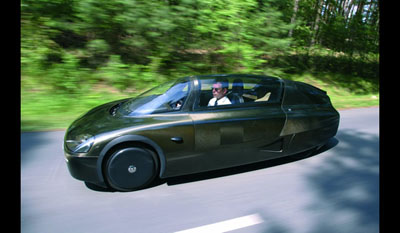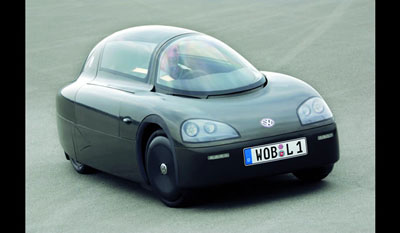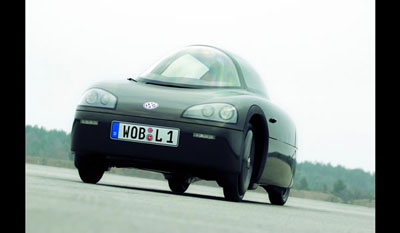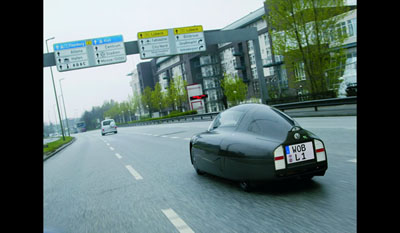Volkswagen 1 Litre Concept 2002
The Volkswagen 1 Litre Concept was unveiled at the 42nd Annual Meeting of Stockholders to demonstrate Volkswagen technology available at the time. The Volkswagen 1 Litre Concept was developped with the objective to obtain a vehicle with a fuel consumption of no more than one litre per 100 kilometres. The principal point was to show how state-of-the art technology can be used to reduce fuel consumption and still come up with a safe, usable and roadworthy vehicle. Volkswagen's research and Development division took up the challenge to design the most economical car and created a ready to drive car in just three years. Volkswagen'study is registered for use on public highways, and the journey from Wolsburg to Hamburg demonstrates that the 1 Litre car is technically feasible and offers driving pleasures of a very special kind. The key objectives were to minimize all driving resistances through lightweight construction and outstanding aerodynamics, and to develop new tyres and running gear components, taking ergonomics, current safety standards and familiar control functions into account. The target, however, meant abandoning conventional vehicle concepts. With a width of just 1,25 metres, the 1 Litre car is extraordinarily narrow, the driver and passenger sit in tandem, the transversely installed engine is centrally located in front of the rear axle, the plastic bodywork has the highly aerodynamic shape of a teardrop. In close collaboration with numerous suppliers, existing components were examined, assessed and modified, and brand new concepts were advanced. This is the case, in particular, for the wheels/tyres, the starter-alternator, the bodywork and the lighting. Different drive concept simulations showed that diesel was the only real option as this combustion principle meets the maximum requirements for optimum energy exploitation. With a displacement of 299 cc., the diesel engine generates an output of 6.3 kW/8.5 hp at 4.000 rpm and a maximum torque of 18,4 Nm at 2.000 rpm. The high-tech unit with direct injection technology weighs a mere 26 kilograms. Ready for operation, including the strarter-alternator, it is just 12 kilograms more. Starter-alternator, start-stop system and freewheel function help save fuel. Six-speed gearbox selects gears sequentially and automatically. The automated gearbox is coupled to a start-stop system, which includes freewheel function. In overrun mode, the vehicle switches the engine off. The vehicle then rolls without the engine running. The engine starts up again immediately when the magnesium accelerator pedal is depressed. A specially developed starter-alternator makes sure the engine is immediately restarted. Positioned between the engine and gearbox and using a dual clutch system, this works as both current generator and flywheel. In freewheeling mode, both clutches are open. When the driver presses the accelerator pedal again, the clutch between the engine and the starter-alternator is closed, causing the still turning flywheel to restart the engine without consuming electrical current. Apart from this, the crankshaft starter-alternator, which eliminates the need for a conventional alternator and starter motor, has a so-called boost function which is able to supply additional power to supplement the power of the engine. But that is not all the starter-alternator does. While braking, the negative acceleration energy is fed into the alternator and recovered.
The silhouette of the 1 Litre car and its front view are reminiscent of a narrow sports car. The aerodynamic coefficient Cd is 0.159. Since the 1 Litre was to be a two-seater and with minimum frontal area, the only option was to arrange the two seats in line. Entry is effected via a 1.5 metre long gullwing door which is drawn down on the left side. The wheels have been sheltered. There are no rear view mirror and the rear visibility is ensured via cameras in the side turn signals. Even the side cooling inlets only open when the engine needs cooling, and otherwise stay shut. The passive safety level correspond to that of a GT sports car registered for racing. With the aid of computer simulation, all kinds of crash types were investigated and the vehicle designed accordingly. Active safety is provided by four-channel ABS and the electronic stability program ESP. A further element for fuel saving is the optimization of the electrical consumers in the vehicle. The Volkswagen 1 Litre concept has Bi-Xenon headlights. The daylight beam , all turn signals and the rear light clusters are in LED technology. Specifications: Engine Diesel, 299 cc, 3 valves per cylinder, 2.000 bar direct injection system, 26 kg, 8.5 hp at 4.000 rpm, 18.4 Nm at 2.000 rpm. Top speed 120 kph, 0,99 Litre/100 km with 650 km range with a single filling. Dimensions 365 cm long, 125 cm wide , 111 cm high and total weight 290 kg. luggage volume 80 litres Wallpapers of the Volkswagen 1 Litre Concept 2002
Related Articles :
|
||||||||||||||||||||||||||
|---|---|---|---|---|---|---|---|---|---|---|---|---|---|---|---|---|---|---|---|---|---|---|---|---|---|---|
Other VolksWagen listed |
|||||||








